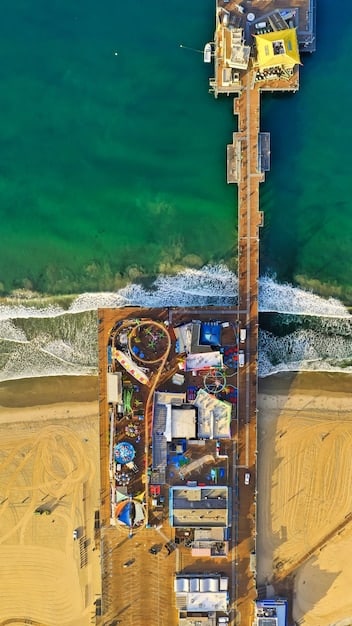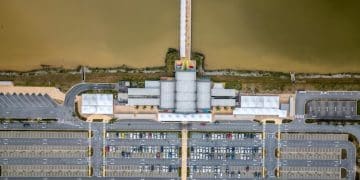Mexico’s Infrastructure Projects 2025: Opportunities for US Companies

US companies are poised to capitalize on significant opportunities within Mexico’s burgeoning infrastructure sector in 2025, driven by nearshoring trends, government investment, and a strategic geographic position, fostering cross-border collaboration and economic growth.
The landscape of global trade and manufacturing is continually shifting, and Mexico has emerged as a focal point for companies seeking strategic advantages. Amid this dynamic environment, Mexico’s Infrastructure Projects: Opportunities for US Companies in 2025 represents a critical area of interest. This burgeoning sector, fueled by a renewed focus on supply chain resilience and regional integration, is opening doors for significant investment and collaboration from the United States, promising mutual economic benefits.
Understanding Mexico’s Infrastructure Landscape in 2025
Mexico’s infrastructure development in 2025 is characterized by a strategic push to enhance its connectivity, logistics, and industrial capacity. This drive is largely influenced by the global shift towards nearshoring, where companies are relocating production closer to their primary markets to mitigate geopolitical risks and supply chain disruptions. Geographically, Mexico is uniquely positioned to benefit from this trend, sharing a vast border with the United States, its largest trading partner.
The Mexican government, recognizing the potential for economic growth and job creation, has committed significant resources to infrastructure projects. This commitment is evident in various large-scale initiatives designed to improve transportation networks, energy infrastructure, and industrial parks. These projects are not merely about construction; they are about building a more efficient and competitive economy that can support increased trade and investment.
Key Drivers of Infrastructure Growth
Several factors are converging to accelerate Mexico’s infrastructure development. One primary driver is the increased demand for industrial spaces, warehouses, and logistics hubs, particularly in regions bordering the US. This demand stems directly from the influx of foreign direct investment (FDI) as companies establish new manufacturing facilities and distribution centers.
Another significant factor is the modernization of existing infrastructure. Many of Mexico’s roads, ports, and railway systems require upgrades to meet the demands of higher trade volumes. This presents opportunities not only for new construction but also for renovation, maintenance, and technological integration. The focus is on creating a seamless flow of goods and services across the country and, crucially, across the US border.
Environmental and sustainability considerations are also gaining traction, influencing project design and implementation. There is a growing emphasis on green infrastructure, renewable energy projects, and sustainable urban development. This aligns with global trends and provides US companies with expertise in these areas a competitive edge.
- Nearshoring Boom: Relocation of manufacturing closer to the US market.
- Government Investment: Significant public and private sector funding for key projects.
- Strategic Location: Mexico’s proximity and trade agreements with the US.
- Demand for Modernization: Upgrading existing, often aging, infrastructure.
The confluence of these factors creates a fertile ground for US companies. Their advanced technological capabilities, project management expertise, and access to capital make them ideal partners for Mexico’s ambitious infrastructure agenda. Understanding these underlying drivers is crucial for identifying the most promising areas for engagement and investment in the coming year.
Major Infrastructure Projects and Their Opportunities
As 2025 approaches, several large-scale infrastructure projects in Mexico stand out, offering significant avenues for US companies. These initiatives span various sectors, from transportation to energy, and are designed to bolster Mexico’s economic competitiveness and integration with North American supply chains. Each project presents unique challenges and opportunities, requiring specialized expertise and strategic partnerships.
Key Transportation Initiatives
Transportation infrastructure remains a top priority, crucial for facilitating the movement of goods and people. Projects like the Interoceanic Corridor of the Isthmus of Tehuantepec (CIIT) are transformative, aiming to connect the Pacific and Atlantic oceans through rail and road networks, offering an alternative to the Panama Canal. This vast undertaking includes port modernization, railway construction, and the development of industrial parks along the corridor.
Beyond this major corridor, significant investments are directed towards improving existing highway networks and constructing new ones, particularly those connecting industrial hubs to border crossings and seaports. The expansion and modernization of airports are also ongoing, vital for both commercial and cargo flights. These projects require extensive civil engineering, material supply, and logistics management expertise.
Energy and Utilities Projects
Mexico’s energy sector is undergoing a transformation, with a focus on enhancing energy security and transitioning towards cleaner sources. Opportunities exist in the development of new natural gas pipelines, essential for supplying industrial centers and power plants. Renewable energy projects, particularly in solar and wind power, are also gaining momentum, driven by both economic incentives and sustainability goals. US companies specializing in renewable energy technologies, project financing, and smart grid solutions will find fertile ground.
Water infrastructure is another critical area. Investment is needed in water treatment plants, desalination facilities, and improved distribution networks, especially in rapidly growing urban and industrial areas. These projects address vital public needs and offer opportunities for companies with expertise in water management and environmental engineering.
Industrial and Urban Development
The nearshoring phenomenon has spurred the rapid expansion of industrial parks and logistics centers, particularly in northern Mexico. These developments require not only the construction of facilities but also the provision of reliable utilities, transportation links, and supporting urban infrastructure for workers. US companies can participate in the master planning, construction, and operation of these industrial zones.
Furthermore, sustainable urban development projects are becoming increasingly important, focusing on smart cities, public transportation, and green building initiatives. These developments aim to create livable and efficient environments that support economic growth while minimizing environmental impact. US expertise in urban planning, smart technologies, and sustainable construction practices is highly valued in these areas.
- Mexico City New Airport (AIFA): Ongoing expansion and connectivity improvements.
- Interoceanic Corridor (CIIT): Rail, road, and port development across the Tehuantepec Isthmus.
- Renewable Energy Parks: Development of solar and wind farms.
- Border Infrastructure: Modernization of customs facilities and cross-border logistics.
These projects are complex and often require significant capital, technological innovation, and a deep understanding of local regulations and cultural nuances. For US companies, engaging in these initiatives demands careful planning, due diligence, and often, strong local partnerships to navigate the complexities and maximize success.
Key Sectors for US Company Investment
For US companies eyeing opportunities in Mexico’s infrastructure boom, certain sectors present particularly promising avenues for investment and collaboration. These areas align with Mexico’s strategic development goals and leverage the strengths and expertise typically found within the US industrial base. Identifying these key sectors is crucial for targeted market entry and maximizing return on investment.
Logistics and Supply Chain Management
The emphasis on nearshoring and resilient supply chains has placed logistics at the forefront of Mexico’s infrastructure needs. This sector encompasses everything from warehousing and distribution centers to cold chain logistics and last-mile delivery solutions. US companies with advanced logistics technologies, automation expertise, and experience in optimizing supply chain efficiency can offer invaluable services.
Opportunities include developing state-of-the-art warehouses, implementing automated sorting and retrieval systems, and providing integrated logistics software solutions. The demand for efficient cross-border logistics is particularly high, creating a niche for companies that can streamline customs processes and transport networks between the US and Mexico.
Renewable Energy Technologies
Mexico is increasingly committed to diversifying its energy matrix and expanding its share of renewable energy. This commitment, coupled with the rising global demand for sustainable solutions, opens doors for US companies specializing in solar, wind, geothermal, and hydroelectric power. Opportunities span the entire project lifecycle, from feasibility studies and project development to equipment supply, construction, and long-term operation and maintenance.
Beyond utility-scale projects, there is growing interest in distributed generation and microgrids, especially for industrial parks seeking reliable and sustainable power sources. US expertise in innovative energy storage solutions, smart grid technologies, and energy efficiency programs is highly sought after.

Construction and Engineering Services
The sheer volume and complexity of Mexico’s infrastructure projects translate into robust demand for construction and engineering services. This includes everything from heavy civil construction for roads, bridges, and ports to specialized engineering for complex energy facilities and industrial plants. US engineering firms can contribute their expertise in project design, feasibility assessment, advanced construction techniques, and quality control.
Furthermore, there is a strong need for specialized construction materials, equipment, and innovative building technologies. Companies offering sustainable building solutions, prefabrication techniques, and advanced construction machinery will find a receptive market eager for efficiency and quality.
- Industrial Park Development: Design, build, and management of specialized industrial zones.
- Water and Wastewater Treatment: Technologies and services for efficient water management.
- Digital Infrastructure: Expansion of broadband, 5G networks, and data centers.
- Smart City Solutions: Urban planning, traffic management, and public safety technologies.
Each of these sectors is interconnected, and success often hinges on a holistic approach that integrates various solutions. US companies that can offer comprehensive packages, combining technological expertise with project management capabilities, are likely to gain a significant competitive advantage in Mexico’s vibrant infrastructure market.
Navigating the Regulatory and Business Environment
Engaging in Mexico’s infrastructure sector requires a clear understanding of its regulatory framework and business landscape. While opportunities are abundant, successful market entry and project execution depend on navigating legal, political, and cultural nuances. US companies must be prepared for a dynamic environment that, while generally welcoming to foreign investment, also has specific requirements and challenges.
Understanding Key Regulations and Policies
Mexico’s infrastructure projects often involve complex permitting processes, land acquisition laws, and environmental regulations. Companies must conduct thorough due diligence to understand these requirements and ensure full compliance. Familiarity with specific laws related to public procurement, foreign investment, and labor is also critical. These regulations can vary significantly depending on the type and location of the project.
Recent policy shifts, particularly in the energy sector, have emphasized state-owned enterprises, which can influence contracting opportunities. However, the government also recognizes the vital role of private and foreign investment in achieving its infrastructure goals. Staying abreast of current policy directions and engaging with local legal experts will be essential.
Building Local Partnerships
Forming strategic alliances with Mexican companies is often a key success factor. Local partners can provide invaluable insights into the business culture, navigate regulatory hurdles, and offer established networks within the government and private sector. These partnerships can range from joint ventures for large projects to subcontracting arrangements for specialized services. Building trust and a strong working relationship is paramount.
Beyond traditional partnerships, engaging with regional business chambers, industry associations, and local communities can also facilitate smoother project implementation. Demonstrating a commitment to local development and social responsibility can enhance a company’s reputation and foster a more collaborative environment.
Addressing Common Challenges
While Mexico offers attractive opportunities, challenges such as bureaucratic delays, security concerns in certain regions, and competition from international players exist. US companies should develop robust risk mitigation strategies that account for these factors. This includes comprehensive legal and financial planning, strong security protocols, and adaptable project management approaches.
Furthermore, cultural understanding is vital. Adapting business practices to local customs, communicating effectively in Spanish, and showing respect for Mexican traditions can significantly improve business outcomes and foster long-term relationships.
- Legal Compliance: Thorough understanding of public procurement laws, environmental regulations.
- Cultural Nuances: Adapting business practices and communication styles.
- Security Protocols: Implementing robust strategies for personnel and assets.
- Political Landscape: Monitoring policy changes and engaging with stakeholders.
Successfully navigating Mexico’s regulatory and business environment is an ongoing process that requires patience, flexibility, and a willingness to learn. Companies that invest in understanding these dynamics and building strong local relationships will be best positioned to capitalize on the substantial infrastructure opportunities available in 2025 and beyond.
Financing Avenues for US Companies
Securing adequate financing is a critical component for US companies looking to participate in Mexico’s infrastructure projects. The scale and complexity of these undertakings often require diverse funding mechanisms, blending public, private, and international sources. Understanding the available financing avenues and strategically approaching them can make a significant difference in project feasibility and success.
Multilateral and Development Bank Funding
International financial institutions play a crucial role in funding large-scale infrastructure projects in emerging markets like Mexico. Organizations such as the Inter-American Development Bank (IDB), the World Bank (IBRD), and the North American Development Bank (NADB) provide loans, guarantees, and technical assistance. These institutions often prioritize projects that promote sustainable development, regional integration, and economic growth.
For US companies, partnering with local entities or directly engaging with these banks can unlock access to substantial capital, often on favorable terms. Familiarity with their financing criteria and application processes is essential for tapping into these significant resources.
Export-Import Bank (EXIM) and US Development Finance Corporation (DFC)
The United States government offers direct support for US companies operating internationally through institutions like the Export-Import Bank (EXIM) and the US International Development Finance Corporation (DFC). EXIM provides finance and insurance solutions to help US businesses export goods and services, including those involved in infrastructure projects. This can include direct loans, loan guarantees, and export credit insurance.
DFC, on the other hand, invests in private sector-led development projects, including infrastructure, particularly in developing countries. They offer debt financing, equity investments, political risk insurance, and technical development. For US companies, these institutions can de-risk projects and provide the necessary capital to compete effectively in the Mexican market.

Private Sector Investment and Public-Private Partnerships (PPPs)
Private sector capital remains a dominant force in infrastructure financing. Private equity funds, infrastructure funds, and commercial banks are actively seeking opportunities in Mexico, especially for projects with predictable revenue streams and strong economic fundamentals. US companies can explore direct investment, joint ventures with private Mexican firms, or participation in syndicated loans.
Public-Private Partnerships (PPPs) are a common and increasingly favored model for infrastructure development in Mexico. PPPs allow the government to leverage private sector efficiency, innovation, and capital, while private companies benefit from long-term contracts and potentially attractive returns. Understanding Mexico’s legal framework for PPPs and developing compelling proposals that address both public and private interests is crucial for securing these contracts.
- Local Banking Sector: Engagement with major Mexican banks for project financing.
- Corporate Bonds: Issuing bonds in local or international markets for large projects.
- Foreign Direct Investment (FDI): Attracting capital directly from international sources.
- Green Bonds: For projects with strong environmental sustainability credentials.
A comprehensive financing strategy for Mexican infrastructure projects often involves a mix of these avenues. Companies should assess their financial needs, risk appetite, and the specific requirements of each project to secure the most appropriate and sustainable funding. Engaging with financial advisors with expertise in regional markets can provide invaluable guidance in navigating this complex landscape.
Case Studies and Success Stories for Inspiration
Examining past and ongoing collaborations between US companies and Mexican entities in infrastructure can provide valuable insights and inspiration. These success stories highlight effective strategies, common pitfalls overcome, and the tangible benefits derived from such partnerships. Learning from these experiences can help new entrants refine their approaches and increase their likelihood of success.
One notable area of success has been in the automotive sector, where US manufacturers have established extensive supply chains and production facilities in Mexico. This has driven demand for specialized industrial parks, efficient transportation networks, and reliable energy supply, leading to numerous successful infrastructure projects involving US contractors and technology providers. This symbiotic relationship demonstrates the multiplier effect of foreign investment in manufacturing driving infrastructure development.
Cross-Border Logistics Hubs
Several US logistics companies have successfully established and expanded major distribution centers and cross-border logistics hubs in Mexican states bordering the US, such as Nuevo León, Coahuila, and Chihuahua. These facilities involve substantial investment in warehousing, IT systems, and multimodal transport connections. Their success is largely attributed to a deep understanding of customs regulations, efficient management of goods, and the integration of advanced tracking technologies. These projects directly support the growing trade volume between the two countries.
Renewable Energy Projects
US firms have also been instrumental in the development of Mexico’s renewable energy sector. For instance, US developers and investors have participated in the construction of large-scale solar and wind farms in states with high potential for renewable resources, like Baja California, Sonora, Oaxaca, and Coahuila. These projects often involve complex financing structures, long-term power purchase agreements, and cutting-edge technology transfer, demonstrating successful collaboration in a rapidly expanding sector.
Public-Private Partnerships in Roads
While not always highly publicized, US construction and infrastructure investment firms have participated in various public-private partnership (PPP) projects for road and highway development in Mexico. These typically involve long-term concessions for the construction, maintenance, and operation of toll roads. Such ventures require meticulous financial planning, robust engineering capabilities, and a strong partnership with local governmental entities, showcasing a successful model for large-scale infrastructure delivery.
- Maquiladora Infrastructure: Development of dedicated industrial zones with integrated utilities for specific industries.
- Telecommunications Towers: US companies investing in and building out Mexico’s mobile and internet network infrastructure.
- Special Economic Zones: US expertise contributing to the planning and development of economic corridors.
- Airport Modernization: Participation in upgrades and expansions of key international airports.
These case studies underscore that success in Mexico’s infrastructure sector is often predicated on a combination of factors: strategic vision, technological superiority, strong local partnerships, a detailed understanding of the regulatory landscape, and adaptable financing strategies. These real-world examples serve as powerful testimonials to the significant opportunities that await US companies in 2025.
Future Outlook and Recommendations for US Businesses
The future outlook for US companies in Mexico’s infrastructure sector in 2025 appears promising, driven by sustained nearshoring interest and the continued need for modernization and expansion. However, success will depend on a proactive and strategically informed approach. Understanding evolving trends and adhering to best practices will be crucial for capitalizing on projected growth and navigating potential challenges effectively.
Anticipated Trends and Opportunities
Looking ahead, several trends are likely to shape the infrastructure landscape. The demand for “smart” infrastructure — incorporating IoT, AI, and big data for optimized performance and sustainability — is expected to grow. This includes smart urban planning, intelligent transportation systems, and advanced energy grids. US companies with expertise in these cutting-edge technologies will find a competitive advantage.
Furthermore, the focus on sustainable and resilient infrastructure will intensify, driven by climate change concerns and the desire for long-term economic stability. Projects incorporating renewable energy, water conservation, and eco-friendly construction materials will gain prominence. The continuous push for greater integration of North American supply chains will also ensure a steady flow of investment into cross-border logistics and industrial facilities.
Strategic Recommendations for US Companies
For US businesses considering or already engaged in Mexico’s infrastructure, several recommendations stand out. Firstly, prioritize comprehensive market research and due diligence for any specific project or region. Understand local economic conditions, political dynamics, and community needs. Secondly, cultivate strong, transparent, and long-term relationships with local partners. These alliances are invaluable for navigating cultural nuances, regulatory complexities, and fostering trust.
Thirdly, embrace technological innovation. Mexico is keen to adopt advanced solutions that improve efficiency, reduce costs, and enhance sustainability. Fourthly, develop flexible financing strategies, leveraging a mix of multilateral, government-backed, and private sector funding. Finally, maintain a robust risk management framework that addresses security, political, and economic volatilities.
- Long-term Planning: Focus on sustainable returns and enduring partnerships.
- Technological Transfer: Offer advanced solutions that benefit Mexico’s development.
- Local Content: Maximizing local sourcing and employment where feasible.
- ESG Focus: Incorporating Environmental, Social, and Governance principles into projects.
The opportunities in Mexico’s infrastructure sector in 2025 are significant and multifaceted. By combining their world-class expertise, innovative technologies, and strategic capital with a deep understanding of the Mexican context, US companies are well-positioned to contribute to Mexico’s growth while securing substantial returns for themselves. This mutually beneficial relationship holds the key to enhancing North American competitiveness and fostering stronger economic ties.
| Key Area | Brief Description |
|---|---|
| 🏗️ Infrastructure Growth | Driven by nearshoring and government investment, focusing on transport, energy, and industrial development. |
| 💰 Financing Avenues | Opportunities through Multilateral Banks, US EXIM/DFC, and Public-Private Partnerships. |
| ⚙️ Key Investment Sectors | Logistics, renewable energy, and construction services offer significant potential for US firms. |
| 🤝 Strategic Partnerships | Essential for navigating the local regulatory environment and ensuring project success. |
Frequently Asked Questions About Mexico’s Infrastructure Opportunities
▼
The primary drivers include the ongoing nearshoring trend, where companies are relocating production closer to the US, significant government investment in key projects, and Mexico’s strategic geographic location, which facilitates greater trade and logistics activities. Additionally, modernization of aging infrastructure and a push towards sustainable development are contributing factors.
▼
Sectors with high potential for US companies include logistics and supply chain management, driven by increased trade volumes; renewable energy technologies, given Mexico’s commitment to clean energy; and construction and engineering services, essential for building and upgrading new facilities and networks. Digital infrastructure and smart city solutions are also emerging areas.
▼
Financing options are diverse and include engaging with multilateral development banks (e.g., IDB, World Bank), leveraging US government support through the Export-Import Bank (EXIM) and US Development Finance Corporation (DFC), and tapping into private sector investment and Public-Private Partnerships (PPPs). A blended finance approach is often the most effective.
▼
Key challenges can include navigating complex regulatory and permitting processes, understanding specific policy shifts, dealing with bureaucratic delays, and managing security concerns in certain regions. Cultural differences and the need for strong local partnerships also present a learning curve that requires careful attention and adaptation.
▼
Nearshoring is a significant factor because as more US companies move their manufacturing closer to home, they require robust infrastructure in Mexico to support these operations. This includes improved transportation networks, reliable energy supply, modern industrial parks, and efficient logistical services, all driving substantial investment and development in these areas.
Conclusion
The strategic convergence of global supply chain reconfigurations and Mexico’s proactive investment in its national infrastructure creates an unparalleled landscape of opportunity for US companies in 2025. From bolstering logistics capabilities to advancing renewable energy initiatives and building resilient urban centers, the potential for cross-border collaboration is immense. Success hinges on a clear understanding of the regulatory environment, the cultivation of strong local partnerships, and a commitment to innovation and sustainability. As Mexico continues its trajectory of economic development, US companies are uniquely positioned to be key contributors, fostering mutual growth and reinforcing the vital economic ties between the two nations.





